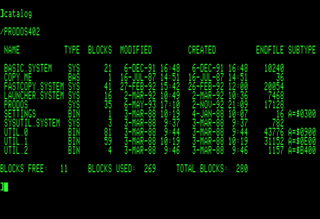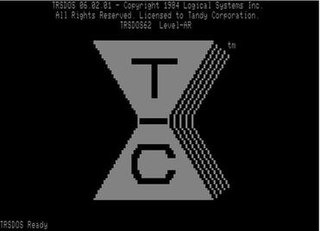Related Research Articles
A RAM drive is a block of random-access memory that a computer's software is treating as if the memory were a disk drive. RAM drives provide high-performance temporary storage for demanding tasks and protect non-volatile storage devices from wearing down, since RAM is not prone to wear from writing, unlike non-volatile flash memory. They are in a sense the reverse of virtual memory: RAM drive uses a volatile fast memory as if it's a nonvolatile slow memory. Virtual memory is the opposite.

In computer data storage, drive letter assignment is the process of assigning alphabetical identifiers to volumes. Unlike the concept of UNIX mount points, where volumes are named and located arbitrarily in a single hierarchical namespace, drive letter assignment allows multiple highest-level namespaces. Drive letter assignment is thus a process of using letters to name the roots of the "forest" representing the file system; each volume holds an independent "tree".
AmigaDOS is the disk operating system of the AmigaOS, which includes file systems, file and directory manipulation, the command-line interface, and file redirection.

ProDOS is the name of two similar operating systems for the Apple II series of personal computers. The original ProDOS, renamed ProDOS 8 in version 1.2, is the last official operating system usable by all 8-bit Apple II series computers, and was distributed from 1983 to 1993. The other, ProDOS 16, was a stop-gap solution for the 16-bit Apple IIGS that was replaced by GS/OS within two years.

The Sophisticated Operating System, or SOS, is the primary operating system of the Apple III computer. SOS was developed by Apple Computer and released in October 1980.
NTLDR is the boot loader for all releases of Windows NT operating system from 1993 with the release of Windows NT 3.1 up until Windows XP and Windows Server 2003. From Windows Vista onwards it was replaced by the BOOTMGR bootloader. NTLDR is typically run from the primary storage device, but it can also run from portable storage devices such as a CD-ROM, USB flash drive, or floppy disk. NTLDR can also load a non NT-based operating system given the appropriate boot sector in a file.

TRSDOS is the operating system for the Tandy TRS-80 line of eight-bit Zilog Z80 microcomputers that were sold through Radio Shack from 1977 through 1991. Tandy's manuals recommended that it be pronounced triss-doss. TRSDOS should not be confused with Tandy DOS, a version of MS-DOS licensed from Microsoft for Tandy's x86 line of personal computers (PCs).
CONFIG.SYS is the primary configuration file for the DOS and OS/2 operating systems. It is a special ASCII text file that contains user-accessible setup or configuration directives evaluated by the operating system's DOS BIOS during boot. CONFIG.SYS was introduced with DOS 2.0.
AUTOEXEC.BAT is a system file that was originally on DOS-type operating systems. It is a plain-text batch file in the root directory of the boot device. The name of the file is an abbreviation of "automatic execution", which describes its function in automatically executing commands on system startup; the filename was coined in response to the 8.3 filename limitations of the FAT file system family.

Atari DOS is the disk operating system used with the Atari 8-bit family of computers. Operating system extensions loaded into memory were required in order for an Atari computer to manage files stored on a disk drive. These extensions to the operating system added the disk handler and other file management features.

IBMBIO.COM is a system file in many DOS operating systems. It contains the system initialization code and all built-in device drivers. It also loads the DOS kernel (IBMDOS.COM) and optional pre-loadable system components, displays boot menus, processes configuration files and launches the shell.

DOS Plus was the first operating system developed by Digital Research's OEM Support Group in Newbury, Berkshire, UK, first released in 1985. DOS Plus 1.0 was based on CP/M-86 Plus combined with the PCMODE emulator from Concurrent PC DOS 4.11. While CP/M-86 Plus and Concurrent DOS 4.1 still had been developed in the United States, Concurrent PC DOS 4.11 was an internationalized and bug-fixed version brought forward by Digital Research UK. Later DOS Plus 2.x issues were based on Concurrent PC DOS 5.0 instead. In the broader picture, DOS Plus can be seen as an intermediate step between Concurrent CP/M-86 and DR DOS.
.sys is a filename extension used in MS-DOS applications and Microsoft Windows operating systems. They are system files that contain device drivers or hardware configurations for the system.
Amiga support and maintenance software performs service functions such as formatting media for a specific filesystem, diagnosing failures that occur on formatted media, data recovery after media failure, and installation of new software for the Amiga family of personal computers—as opposed to application software, which performs business, education, and recreation functions.

SpartaDOS X is a disk operating system for the Atari 8-bit family of computers that closely resembles MS-DOS. It was developed and sold by ICD, Inc. in 1987-1993, and many years later picked up by the third-party community SpartaDOS X Upgrade Project, which still maintains the software.

DOS is a family of disk-based operating systems for IBM PC compatible computers. The DOS family primarily consists of IBM PC DOS and a rebranded version, Microsoft's MS-DOS, both of which were introduced in 1981. Later compatible systems from other manufacturers include DR-DOS (1988), ROM-DOS (1989), PTS-DOS (1993), and FreeDOS (1998). MS-DOS dominated the IBM PC compatible market between 1981 and 1995.
The IBM Personal Computer Basic, commonly shortened to IBM BASIC, is a programming language first released by IBM with the IBM Personal Computer, Model 5150 in 1981. IBM released four different versions of the Microsoft BASIC interpreter, licensed from Microsoft for the PC and PCjr. They are known as Cassette BASIC, Disk BASIC, Advanced BASIC (BASICA), and Cartridge BASIC. Versions of Disk BASIC and Advanced BASIC were included with IBM PC DOS up to PC DOS 4. In addition to the features of an ANSI standard BASIC, the IBM versions offered support for the graphics and sound hardware of the IBM PC line. Source code could be entered with a full-screen editor, and limited facilities were provided for rudimentary program debugging. IBM also released a version of the Microsoft BASIC compiler for the PC concurrently with the release of PC DOS 1.10 in 1982.
PolyMorphic Systems was a manufacturer of microcomputer boards and systems based on the S-100 bus. Their products included the Poly-88 and the System 8813. The company was incorporated in California in 1976 as Interactive Products Corporation d/b/a PolyMorphic Systems. It was initially based in Goleta, then Santa Barbara, California.

DOS Power Tools: Techniques, Tricks and Utilities is a book by Paul Somerson, first published in 1988 by Bantam Books and sponsored by PC Magazine. The book offers a guide to approaching MS-DOS as well as various tricks and utility programs—the latter provided as x86 assembly source code listings and as compiled .COM and .EXE executables on an accompanying floppy disk. The book was a best-seller and received positive critical reception.